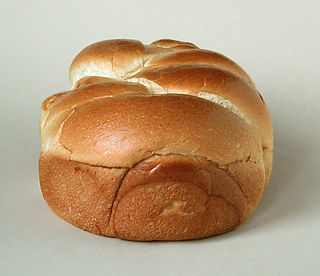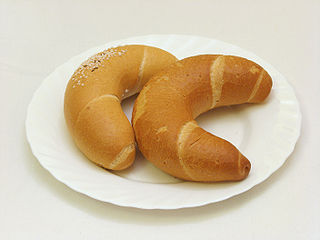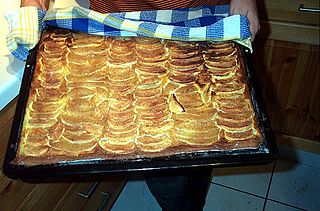
Bread is a staple food prepared from a dough of flour and water, usually by baking. Throughout recorded history, it has been a prominent food in large parts of the world. It is one of the oldest man-made foods, having been of significant importance since the dawn of agriculture, and plays an essential role in both religious rituals and secular culture.

Pane carasau is a traditional flatbread from Sardinia. It is also called carta da musica in Italian, meaning "music sheet", in reference to its large and paper-thin shape, which is said to be so thin before cooking that a sheet of music can be read through it.

Pastry is a dough of flour, water and shortening that may be savoury or sweetened. Sweetened pastries are often described as bakers' confectionery. The word "pastries" suggests many kinds of baked products made from ingredients such as flour, sugar, milk, butter, shortening, baking powder, and eggs. Small tarts and other sweet baked products are called pastries. Common pastry dishes include pies, tarts, quiches, croissants, and pasties.

Sourdough bread is made by the fermentation of dough using naturally occurring lactobacilli and yeast. The lactic acid produced by the lactobacilli gives it a more sour taste and improved keeping qualities.

Brioche is a bread of French origin and whose high egg and butter content gives it a rich and tender crumb. Chef Joël Robuchon described it as "light and slightly puffy, more or less fine, according to the proportion of butter and eggs." It has a dark, golden, and flaky crust, frequently accentuated by an egg wash applied after proofing.

Dough is a thick, malleable, sometimes elastic paste made out of any grains, leguminous or chestnut crops. Dough is typically made by mixing flour with a small amount of water and/or other liquid, and sometimes includes yeast or other leavening agents as well as other ingredients such as various fats or flavorings.
Swiss cuisine is influenced by French, German and Northern Italian cuisine, as well as by the history of Switzerland as a primarily agricultural country. As a result, many traditional Swiss dishes tend to be relatively plain and are made from basic ingredients, such as potatoes and Swiss cheese. The great cultural diversity within Switzerland is also reflected in the great number of regional or local specialties.

Kifli or kipfel is a traditional yeast bread roll that is rolled and formed into a crescent before baking.

A teacake in England is generally a light yeast-based sweet bun containing dried fruit, typically served toasted and buttered. In the U.S. teacakes can be cookies or small cakes. In Sweden, they are soft, round, flat wheat breads made with milk and a little sugar, and used to make buttered ham or cheese sandwiches. In India and Australia, a teacake is more like a butter cake. Tea refers to the popular beverage to which these baked goods are an accompaniment.

Pain de campagne, also called "French sourdough", is typically a large round loaf ("miche") made from either natural leavening or baker's yeast. Most traditional versions of this bread are made with a combination of white flour with whole wheat flour and/or rye flour, water, leavening and salt. For centuries, French villages had communal ovens where the townsfolk would bring their dough to be baked, and the loaves weighed from four to as much as twelve pounds (1.5–5.5 kg). Such large loaves would feed a family for days or weeks, until the next baking day.

Vienna bread is a type of bread that is produced from a process developed in Vienna, Austria, in the 19th century. The Vienna process used high milling of Hungarian grain, and cereal press-yeast for leavening.

Bread is a staple food of Finland. It is served with almost every meal and many different types are produced domestically.

Basler Brot, in Basel also Basler Laibli, is a bread traditionally made in the Swiss cantons of Basel-Stadt and Basel-Landschaft, but now popular in all of Switzerland. It is distinguished from other Swiss breads by a very soft, porous dough and a mealy, crunchy crust.
Zürcher Murren, also called pain bernois, Bernerweggen, Spitzweggen, geschnittene Weggli or Zackenweggen are a type of bread roll traditionally made in the German-speaking part of Switzerland and, more rarely, in the Romandy.

The pane ticinese is a white bread traditionally made in the Swiss canton of Ticino, but also available in the rest of Switzerland, where it is known as "Bread of Ticino". In Ticino, it is referred to by a number of names specific to the region, including pane riga, reale or lireta.

The Bündner Nusstorte, also known as Engadiner Nusstorte, is a traditional sweet, caramelised nut-filled pastry from canton Graubünden in Switzerland. The modern filled Nusstorte was first widely available in the 1960s though it was invented in the 1920s.

Birnbrot or Birnweggen are a traditional pastry originating in Switzerland with a filling of dried pears. They exist throughout Switzerland and popular variations include "Bündener Birnbrot", "Glarner Birnbrot", "Toggenburger Birnbrot" (from Toggenburg and "Luzerner Birnweggen".

Wähe is a flat cake typical of the Swiss and Alemannic cuisine. A Wähe is prepared basically with short pastry - also known in German as "Kuchenteig" - and a topping of either fruits, vegetables or cheese. Wähen are sometimes prepared with yeast dough and occasionally with puff pastry. A Wähe is made with a mixture of milk and eggs, and it rises to become thick and yellow when baked. The fruits or vegetables are baked together with the Wähe. The preparation is thus very similar to that of the French quiche or tarte.
















